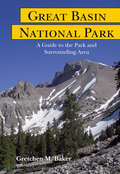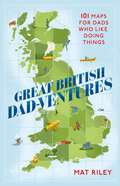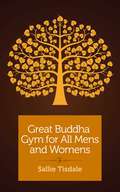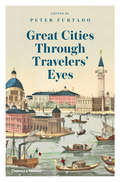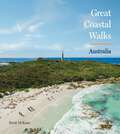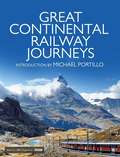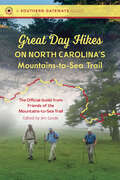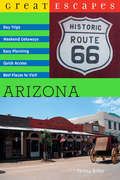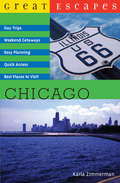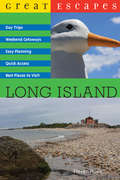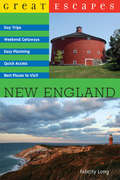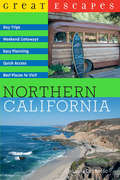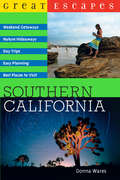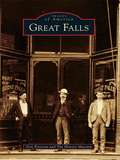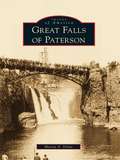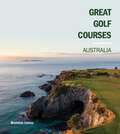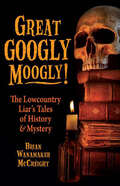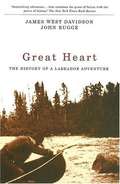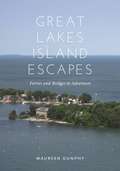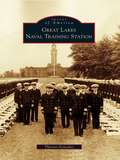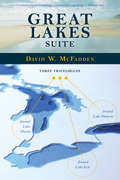- Table View
- List View
Great Basin National Park: A Guide to the Park and Surrounding Area (G - Reference, Information And Interdisciplinary Subjects Ser.)
by Gretchen M. BakerGreat Basin National Park is in large part a high-alpine park, but it sits in one of America’s driest, least populated, and most isolated deserts. That contrast is one facet of the diversity that characterizes this region. Within and outside the park are phenomenal landscape features, biotic wonders, unique environments, varied historic sites, and the local colors of isolated towns and ranches. Vast Snake and Spring Valleys, bracketing the national park, are also subjects of one of the West's most divisive environment contests, over what on the surface seems most absent but underground is abundant enough for sprawling Las Vegas to covet it—water.
Great British Dad-ventures: 101 maps for dads who like doing things
by Mat RileyWATERSTONES' BEST BOOKS OF THE YEAR 2023: NATURE AND TRAVELWhen you're stuck for a great gift for Dad, look no further than GREAT BRITISH DADVENTURES: the ultimate guide to helping Dad discover adrenaline-inducing, mind-expanding or stomach-pleasing mini or big adventures around the British Isles - and families of all ages can join in the fun too!Using maps of all the Scottish and English counties and the Welsh principal areas, the book pinpoints almost 1,000 destinations and activities, including plenty of free and baby-friendly options (and a few that are for Dad's friends only). Whether he's looking for something interesting to do nearby at the weekend or heading off on holiday around our vast and varied British Isles, GREAT BRITISH DAD-VENTURES has all the inspiration Dad needs to get off his screen and do something exciting. Activities include: - walks, hikes, cycling and mountain biking - castles and museums - watersports, wild swimming and boat trips - nature reserves and safari parks - orienteering and bushcraft experiences - scenic driving routes and walking tours - climbing, coasteering and gorge walking - brewery and vineyard tours - and plenty of activities that are unique to the local areas.
Great British Dad-ventures: 101 maps for dads who like doing things
by Mat RileyWATERSTONES' BEST BOOKS OF THE YEAR 2023: NATURE AND TRAVELWhen you're stuck for a great gift for Dad, look no further than GREAT BRITISH DADVENTURES: the ultimate guide to helping Dad discover adrenaline-inducing, mind-expanding or stomach-pleasing mini or big adventures around the British Isles - and families of all ages can join in the fun too!Using maps of all the Scottish and English counties and the Welsh principal areas, the book pinpoints almost 1,000 destinations and activities, including plenty of free and baby-friendly options (and a few that are for Dad's friends only). Whether he's looking for something interesting to do nearby at the weekend or heading off on holiday around our vast and varied British Isles, GREAT BRITISH DAD-VENTURES has all the inspiration Dad needs to get off his screen and do something exciting. Activities include: - walks, hikes, cycling and mountain biking - castles and museums - watersports, wild swimming and boat trips - nature reserves and safari parks - orienteering and bushcraft experiences - scenic driving routes and walking tours - climbing, coasteering and gorge walking - brewery and vineyard tours - and plenty of activities that are unique to the local areas.
Great British Journeys
by Nicholas CraneIntrepid presenter Nicholas Crane investigates eight epic journeys, following in the footsteps of our greatest indigenous explorers.Nick presents eight of the most interesting traveller-chroniclers to have explored and reported on the state of the nation. From Gerald of Wales who embarked on a seven week journey around the wild perimeter of Wales in March 1188, to HV Morton, the journalist and travel writer who crossed the length and breadth of England by car in the 1920s. Others include Celia Fiennes who started her many journeys around Britain on horseback in the late 1600s at the age of 20, Tudor antiquarian John Leland, Daniel Defoe, William Cobbett, Thomas Pennant, and William Gilpin, who travelled through the north of England by boat in 1770.
Great British Journeys
by Nicholas CraneIntrepid presenter Nicholas Crane investigates eight epic journeys, following in the footsteps of our greatest indigenous explorers.Nick presents eight of the most interesting traveller-chroniclers to have explored and reported on the state of the nation. From Gerald of Wales who embarked on a seven week journey around the wild perimeter of Wales in March 1188, to HV Morton, the journalist and travel writer who crossed the length and breadth of England by car in the 1920s. Others include Celia Fiennes who started her many journeys around Britain on horseback in the late 1600s at the age of 20, Tudor antiquarian John Leland, Daniel Defoe, William Cobbett, Thomas Pennant, and William Gilpin, who travelled through the north of England by boat in 1770.
Great Buddha Gym for All Mens and Womens
by Sallie TisdaleIn Great Buddha Gym for All Mens and Womens, author Sallie Tisdale so richly evokes her pilgrimage to the four vital sites related to Buddha Shakyamuni&’s life and enlightenment that the reader feels as if she&’s tripping alongside Tisdale every crowded, colorful, and sensuous step of the way. The challenges of travel in modern India are daunting. The ancient sites are overrun with tourists and seekers. Merchants hawking spiritual goods are everywhere. And yet, miraculously, despite the chaos, the great teachings of the Buddha come shining through.
Great Cities Through Travelers' Eyes
by Peter FurtadoA wide-ranging anthology of travelers’ accounts in thirty-eight of the world’s most fascinating cities, from ancient times through the twentieth century. This entertaining new anthology includes travelers’ tales from thirty-eight cities spread over six continents, ranging from Beijing to Berlin, Cairo to Chicago, and Rio to Rome. The volume features commentators across the millennia, including the great travelers of ancient times, such as Greek geographer Strabo; those who undertook extensive journeys in the medieval world, not least Marco Polo; courageous women such as Isabella Bird and Freya Stark; and enterprising writers and journalists, including Mark Twain. We see the work of famous travelers, but also stories by ordinary people who found themselves involved in remarkable situations, like the medieval Chinese abbot who was shown around the Sainte-Chapelle in Paris by the king of France. Some of the writers seek to provide a straightforward, accurate description of all they have seen, while others concentrate on their subjective experiences of the city and encounters with the inhabitants. Introduced and contextualized by bestselling historian Peter Furtado, each account provides both a vivid portrait of a distant place and time and an insight into those who journeyed there. The result is a book that delves into the splendors and stories that exist beyond conventional guidebooks and websites.
Great Coastal Walks Australia
by Brent McKeanDiscover 40 of Australia's most spectacular coastal walking tracks.Great Coastal Walks Australia showcases each state's best coastal tracks to explore on foot. It features a range of unique locations that reveal Australia's most spectacular coastal scenery, from Sydney's iconic beaches to remote wilderness destinations. Journey with Australia's best bushwalking writers as they explore Victoria's Shipwreck Coast, the Whitsundays, South Australia's Fleurieu Peninsula, Tasmania's Bay of Fires, the iconic Cape to Cape Track in Western Australia and many more. Selected by Great Walks magazine's editor Brent McKean, for each walk there is a history and must-see features along with tips for exploring the standout spots. The stunning colour images will inspire you to start planning your next trek!
Great Continental Railway Journeys
by Michael PortilloGreat Continental Railway Journeysis now a firmly established series on BBC2, following in the illustrious tracks of its predecessor - Great British Railway Journeys. Both series are fronted by ex-politician Michael Portillo and in this European odyssey he travels around continental Europe, using George Bradshaw's1913 Continental Railway Guide. Now coming up for its fourth instalment this autumn, Portillo guides the train-travelling fan across Europe arriving at a myriad of magical and historically fascinating cities we all dream of travelling to by train. From London, to Paris, Bordeaux, Lyon, Copenhagen, Oslo, Lisbon, Madrid, Berlin, Monte Carlo, Prague, Munich, Zurich, Rome, Budapest, St Petersburg; all the way down to Constantinople, Haifa and Jerusalem - Portillo describes the great feats of engineering that built the various railway lines connecting Europe and further afield and the men and women who made these journeys famous through their deeds and words. The new series (6x1-hour) will transmit in early November 2015, and this book will be the official, lavishly illustrated tie-in covering every single journey Portillo has undertaken across Europe. Capturing all the colour, beauty, excitement and fervour of journeying across this historic continent can muster. A must-have purchase for any armchair fan of unique and award-winning travel programming.
Great Day Hikes on North Carolina's Mountains-to-Sea Trail (Southern Gateways Guides)
by Friends of the Mountains-to-Sea TrailThe Mountains-to-Sea Trail is an 1,175-mile destination trail that crosses North Carolina from Clingmans Dome in Great Smoky Mountains National Park to Jockey's Ridge State Park on the Outer Banks. It traverses 37 counties, 7 national parks and forests, and nearly a dozen state parks and historic sites. This is the first-ever guide to day hikes along the crown jewel of North Carolina foot trails. Whether you're a seasoned hiker or new to the outdoors, this official guide from Friends of the Mountains-to-Sea Trail is your go-to companion for exploring all the trail has to offer, showcasing everything from scenic mountain vistas to surprising escapes in the state's Piedmont region and the wonders of coastal plain pocosins. Features include- 40 hikes carefully chosen to appeal to hikers of all experience levels- Helpful hike finder feature to identify the perfect hikes for birding, waterfalls, history, universal accessibility, and more - Turn-by-turn guidance and key points of interest for each hike- Full-color maps and photographs- Helpful information about the trail's history and ongoing development
Great Escapes: Arizona
by Teresa BitlerIntroducing Great Escapes: Selective guides for travelers who want to find quick trips and getaways within a specific locale. They take away the drudgery of sifting through online and printed travel info by listing only the most worthwhile events, activities, and places to stay and eat. Great Escapes: Arizona is for anyone who loves to explore and who wants to discover Arizona in a new and exciting way! Here's just a taste: a drive along historic Route 66; an unbelievable February fireworks display; stargazing at a national observatory; a re-enactment of the Civil War's "westernmost" battles; a visit to the O.K. Corral where Wyatt Earp made his legendary stand; an ostrich festival; and a search for the Lost Dutchman's Gold Mine.
Great Escapes: Day Trips, Weekend Getaways, Easy Planning, Quick Access, Best Places to Visit
by Karla ZimmermanGreat Escapes: Chicago presents fresh weekend escapes both in and around Chicago. Organized in an innovative format, it dispenses information and advice according to themes including “Eat,” “Play,” and “Learn.” As one of the few guidebooks devoted to weekend escapes from Chicago, Great Escapes: Chicago appeals to residents of Chicago and its metropolitan region desiring quick and inexpensive vacations and reignites interest in nearby Chicago.
Great Escapes: Long Island (Great Escapes)
by Steven HowellOver 20 thematically organized weekend getaways throughout all corners of Long Island, including the Belmont Stakes, Shelter Island, Montauk, and more. From the old "Gold Coast" of Long Island's North Shore, made famous by F. Scott Fitzgerald, to the sparkling waters of Jones Beach, the Hamptons and Montauk, Great Escapes: Long Island provides a series of itineraries for packing in all there is to do and see on Long Island. There's something for everyone--from fishing to family fun to wine tours and food tours to visits to little-known historic sites. Each itinerary offers an in-depth narrative about the destination along with pertinent recommendations for lodging, dining, shopping, and sightseeing.
Great Escapes: New England (Great Escapes)
by Felicity LongOver 25 day trips and weekend getaways throughout New England, including escapes to nearby beaches, islands, picturesque villages, mountains, and urban getaways. There's a lot to see and do in New England, and its modest size allows for a spectacular number of diverse short trips, all within an easy drive of Boston, MA, Portland, ME, and Providence, RI. Whether you crave mountains or beaches, the best seafood or the best museums, solitude or boisterous fun, you'll find it all in this guide. With 25 detailed itineraries, where will you go first? Restaurant and lodging recommendations and essential local contact info--it's all you need to enjoy many great escapes.
Great Escapes: Northern California
by Laura Del RossoGreat Escapes: Selective guides for travelers who want to find quick trips and getaways within a specific locale. They take away the drudgery of sifting through online and printed travel info by listing only the most worthwhile events, activities, and places to stay and eat. Great Escapes: Northern California provides at-a-glance trip ideas to major destinations such as San Francisco and Lake Tahoe and lesser-known areas such as the Gold Rush towns of the Sierra foothills and the isolated beaches of the Sonoma coast. Activities range from catching the sunset from the best spot on Monterey Peninsula to hiking to a Sierra Nevada lookout point. Carefully-chosen places to stay all have unique charm or historical significance, and dining options range from Michelin-starred restaurants to local favorites.
Great Escapes: Southern California
by Donna WaresGreat Escapes: Selective guides for travelers who want to find quick trips and getaways within a specific locale. They take away the drudgery of sifting through online and printed travel info by listing only the most worthwhile events, activities, and places to stay and eat. Great Escapes: Southern California: Make the most of the SoCal experience by veering toward some unexpected, eclectic haunts: Go "Sideways" along the back roads of the Santa Ynez Valley, find solitude while camping on Catalina Island or the Gaviota coastline, check out San Diego's hip Gaslamp District, and revel in a 50s-style lodge in the desert of Palm Springs.
Great Falls
by Don Peterson The History MuseumBefore Meriwether Lewis saw the Great Falls of the Missouri River in 1805, the area had been visited for centuries by plains bison and the Blackfeet Indians. The city's founding father, Paris Gibson, learned of the falls from Lewis and Clark's journals, and with financing from railroader James J. Hill, Gibson began building the city of Great Falls in 1884, capitalizing on its Missouri River location. After the railroad arrived, the first of five hydroelectric dams was built, along with smelters for silver and copper. The year 1909 saw the homestead boom and settlers by the thousands, while World War II's construction boom supported large military facilities in the city. Great Falls' good times lasted 90 years.
Great Falls of Paterson (Images of America)
by Marcia A. DenteIn 1778, the Great Falls became the Paterson area's natural energy source. The innovative hydraulic "Raceway" used an intricate network of canals to channel millions of gallons of water to power local mills and factories. In 1791, Alexander Hamilton helped to organize the Society for the Establishment of Useful Manufactures, which aimed to develop a planned industrial city in the United States. Hamilton believed that the country needed to reduce its dependence on foreign goods and develop its own industries, and the falls were chosen as the site for the planned city. The industries in Paterson were powered by the 77-foot Great Falls, and the city became known as "the cradle of American industry." Today the falls are not only a national historic landmark and a state park, but on March 30, 2009, Pres. Barack Obama signed a bill creating Great Falls National Historical Park.
Great Glasgow Stories
by John BurrowesFew cities in the world abound with so many extraordinary stories as Glasgow. The city has been the silent witness to some of the most significant events of the past century, from major triumphs to cataclysmic calamities, and the best of these anecdotes are compiled here to form this unique collection.Amongst the notable events revisited are the launching of the Queen Mary, which captivated the city's inhabitants in 1934, the victorious 16-month work-in campaign by the Upper Clyde Shipbuilders in the early 1970s, the Ibrox disaster of 1971 and the plague that gripped the Gorbals in 1900.Some of Glasgow's most successful people are also covered, including Clydeside revolutionary John Maclean, founder of the Barras Maggie McIver and the inimitable Billy Connolly, whose humour and colourful personality are synonymous with the city.From the Battle of George Square to the bravery of the Glasgow people during the Blitz, Great Glasgow Stories provides an all-encompassing view of the city throughout the eras.
Great Golf Courses Australia
by Brendan JamesProfiles the top 50 golf courses in Australia.Welcome to every golfer's 'must play' list. Great Golf Courses Australia nominates the top locations down under. Features a range of unique locations, from the major metropolitan courses to stunningly diverse locations such as King Island, Kalgoorlie and Port Fairy. It's a best of the best list of astonishingly beautiful and challenging locations for enthusiasts. The line-up was compiled by long-time Golf Australia editor Brendan James. For each course covered there is information on the standout holes, history and features. The stunning colour images, many captured by drone, will inspire golfers to start planning their next trip.
Great Googly Moogly!: The Lowcountry Liar's Tales of History & Mystery
by Brian Wanamaker McCreightStories based upon traditional South Carolina local history and legends fill the pages of this haunting collection. Talented wordsmith Jim Aisle, known as the Lowcountry Liar, spins tales of the supernatural, the weird, the mysterious, and the humorous. These titillating tales are recorded and relayed to the gentle reader by his friend Brian Wanamaker McCr�ight, who tosses in a few of his own yarns to round out this clever collection.Each story begins with a folksy introduction from both the Lowcountry Liar and McCr�ight as they ramble about the region and ends with notes about provenance and fascinating facts. The tales have a life of their own and will resonate with all who have listened in rapt attention around a campfire surrounded by darkness. Included are ghostly legends from the great Late Unpleasantness, more often referred to as the Civil War, with such intriguing titles as "The Silverware Civil War" and the "Cross of St. George." Spooky twists abound in "Love Stinks" and "Mother's Milk." Even the most endearing of timeless tales, such as the popular "The Little White Dog of White Point Garden," are told in the Lowcountry vernacular and will become a favorite of every reader.
Great Heart: The History of a Labrador Adventure
by Bill Mckibben James West Davidson John RuggeIn July 1903 Leonidas Hubbard set out to explore the uncharted interior of Labrador by canoe, accompanied by Dillon Wallace, his best friend, and George Elson, a M?s guide. Bad luck and bad judgment led the expedition into disaster and the party was forced to turn back. Hubbard died of starvation just thirty miles from camp.
Great Lakes Island Escapes: Ferries and Bridges to Adventure (Painted Turtle)
by Maureen DunphyThe Great Lakes Basin is the largest surface freshwater system on Earth. The more than 30,000 islands dotted throughout the basin provide some of the best ways to enjoy the Great Lakes. While the vast majority of these islands can only be reached by private boat or plane, a surprising number of islands—each with its own character and often harboring more than a bit of intrigue in its history—can be reached by merely taking a ferry ride, or crossing a bridge, offering everyone the chance to experience a variety of island adventures. Great Lakes Island Escapes: Ferries and Bridges to Adventure explores in depth over 30 of the Great Lakes Basin islands accessible by bridge or ferry and introduces more than 50 additional islands. Thirty-eight chapters include helpful information about getting to each featured island, what to expect when you get there, the island’s history, and what natural and historical sites and cultural attractions are available to visitors. Each chapter lists special island events, where to get more island information, and how readers can help support the island. Author Maureen Dunphy made numerous trips to a total of 135 islands that are accessible by ferry or bridge in the Great Lakes Basin. On each trip, Dunphy was accompanied by a different friend or relative who provided her another adventurer’s perspective through which to view the island experience. Great Lakes Island Escapes covers islands on both sides of the international border between the United States and Canada and features islands in both the lakes and the waterways that connect them. Anyone interested in island travel or learning more about the Great Lakes will delight in this comprehensive collection.
Great Lakes Naval Training Station (Images of America)
by Therese GonzalezGreat Lakes Naval Training Station was authorized as a "training ship on land" in 1904. The base opened on July 1, 1911, and the first class of 300 U.S. sailors graduated four months later in a grand ceremony attended by Pres. William H. Taft as guest of honor. It has since sent to the fleet over four million sailors, serving the nation through all the conflicts of the 20th century. Today Great Lakes is the sole remaining navy boot camp in the United States. Anchored by the stately Building One, the entire 43-building complex was designated as Great Lakes Naval Training Station on the National Register of Historic Places in 1986. This book, with over 200 vintage images, explores its colorful and important history.
Great Lakes Suite
by David W. McfaddenSpecially edited, updated, revised and rewritten by the author, and for the first time complete in one volume, Great Lakes Suite includes A Trip Around Lake Ontario, first published in 1988, as well as A Trip Around Lake Erie and A Trip Around Lake Huron, both of which were first published in 1980. These books have come alive in a remarkable way and have made the whole much more than merely the sum of its parts. They have become funnier, sadder, more inter-connected, more spiritual, more sure of themselves. They sparkle from beginning to end with a new depth and resonance. They represent a time that is no more, an idyllic time (so it seems now) before the differences between Canada and the U.S. became so small as to be a joke. The years since they first appeared have been kind to these books and McFadden's extensive reworking of the texts has given them a heightened sheen.
